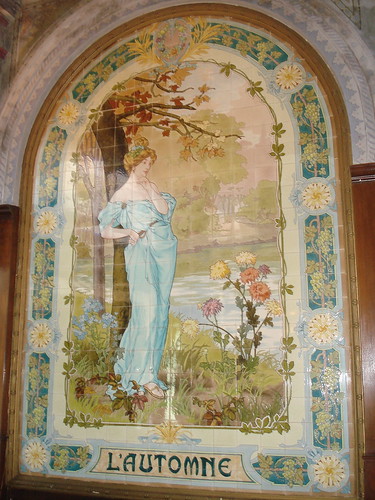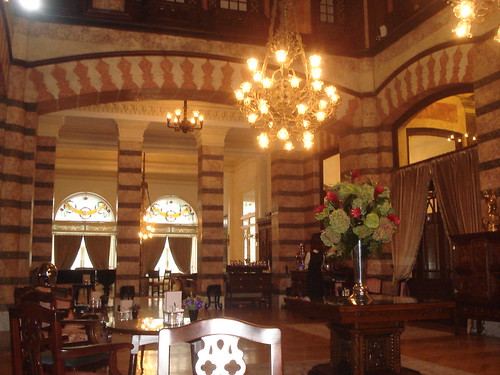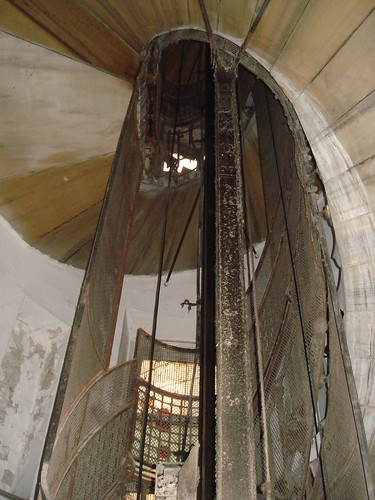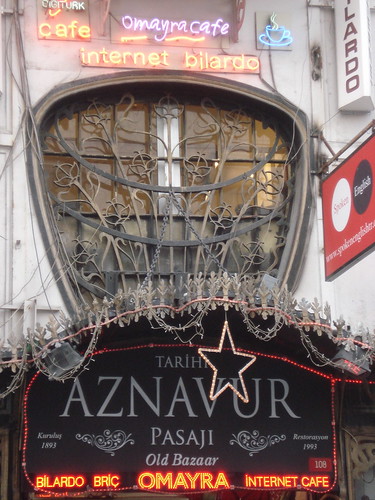 |
| Grande Rue de Pera, now Istiklal Caddesi, Istanbul, late 19th century |
Luckily, the bored looking woman behind the counter merely held out her hand for the passport (and the money), gave it a cursory glance and put the sticker into my passport saying I could stay for up to 90 days but that I wasn't to work. A nice thought, no work for 90 days. I was only staying for four days. Istanbul was much changed from my memories of the previous visit and I discovered many things I had managed to miss before.
I had planned the visit for some time and the date kept changing. That was because I wanted to stay in the Pera Palace Hotel in Beyoglu. The hotel had been undergoing an extensive refurbishment which was delayed several times, but it was certainly worth the wait. Work on the hotel commenced in 1892 and was completed in 1895. Architect Alexander Vallaury, born in Istanbul but with French connections, designed the building in a combination of Levantine, Moorish and art nouveau styles that have been retained for the most part.
The hotel has had many famous guests over the years. Agatha Christie stayed here and was inspired to write "Murder on the Orient Express" - rather apt as the hotel's initial heyday coincided with many more people travelling across Europe and making their way to Istanbul. Many Orient Express passengers are known to have stayed at the Pera Palace. Greta Garbo, Zsa Zsa Gabor, Alfred Hitchcock and Ernest Hemingway also stayed here, but the most famous guest was Kemal Ataturk, founder of the Turkish Republic. He was first a guest in 1917 and the hotel has a small museum to commemorate the times he spent there.
The hotel was extremely modern for its time and had the first electric lift in Turkey. The lift, which can still be seen (although not used) today was described by Daniel Farson as "...the most beautiful elevator in the world...it ascends like a lady who curtsies. Tourists cannot take their eyes off this utterly pretty and aristocratic elevator". The new look hotel includes a restored patisserie (interestingly), a beautiful lounge (pictured here) and a more functional dining room - the Agatha Room - named for Ms Christie. I asked for a room with a view of the Golden Horn and got one - which meant I could see great sunsets and early morning views of Yeni Cami (which means new mosque - well, it was in 1663 when it was completed) and the Suleymaniye Mosque on the other side of the water. Lovely.
One of my reasons for returning to Istanbul was to explore the art nouveau buildings I hadn't really known about the time before. Many of these are located on and around Istiklal Caddesi (Independence Street), formerly known in late Ottoman times as the Grand Rue de Pera. I love this street. Pedestrianised, day and night it is thronged with Turks and tourists, shopping, selling, talking, loitering, drinking coffee, trying to get on the single car tram that runs up and down its length or just promenading to see and be seen.
 |
| L'automne at the Markiz Patisserie |
Istiklal Caddesi has lost many of the art nouveau gems it once had but a few remain. Perhaps the best known of these is the former Markiz Pastanesi at number 362. It started life as the Lebon patisserie and was once the hub of stylish bohemia in Istanbul. It is now owned by a pretty dreadful fast food chain. Thankfully, many of the original features have been retained at ground floor level including the gorgeous tile panels "Printemps" and "L'Automne". The Markiz was also designed by Vallaury whilst the panels were the work of J A Arnoux. Panels were originally produced for all four seasons by Ch. Boulanger at Choisy-Le-Roi and shipped to Istanbul, but only Spring and Autumn arrived intact and were installed in the 1920's. Beautiful art deco stained glass windows have also survived in the adjoining corridor. A must see for anyone interested in art nouveau or deco, and they don't mind if you take photos - but stick with coffee and pastry rather than eating a meal here.
Further down the avenue, at number 212, lies the Aznavur Pasaji, somewhat damaged by a poor quality upper extension, it still retains some of its nouveau features, especially the window grating over the entrance and the brackets supporting the bow window. There are many other buildings in the street with art nouveau features, some in terrible condition, others being lovingly restored. Look up as you walk along, or if you have the nerve, push on the main door to apartment buildings and peep inside the lobbies and stairwells where the bold will be rewarded with a glimpse of bygone splendour.
Istiklal Caddesi is also home to some excellent book shops, several of which sell books in English - and not just the regular tourist aimed books with post card style pictures, but more interesting items looking at the history of Istanbul, collections of photographs from the early years of the 20th Century as well as Turkish writing translated into English.
I especially like the works of Orhan Pamuk and Elif Shafak. Pamuk's autobiographical book "Istanbul" is a must read for devotees of this city, leading you through back alleys, inside the old yalis (wooden houses) by the water and also inside the culture of bourgeois Istanbul families of the middle and later part of the 20th century. His fiction is equally compelling, if not the easiest read. "The Black Book" transported me to some very dark places in this huge city. I could feel the biting cold of a winter's night in the poor parts of the city and the confusion of the narrator as he begins to assume the identity of a missing (murdered) journalist during Turkey's dark political days of the 1970's.
Both Ms Shafak and Mr Pamuk have been in trouble with the authorities for referencing the Turkish genocide of the Armenians before, during and after the First World War, something still not acknowledged in Turkey. Shafak is a more accessible writer than Pamuk and I love her well drawn characters, particularly the women and the ever present sense of how the present and the future are impacted on by the past. Like Pamuk, her stories are full of unfolding secrets, some shocking, others amusing. Try "The Bastard of Istanbul" or "The Flea Palace". Her characters are diverse and include Armenians and Jews as well as "Turkish Turks".
My favourite shop on Istiklal Caddesi has to be Denizler Kitabevi. Small but beautiful, it is packed with new books, antiquarian books, prints of historical scenes of the city, paintings and "interesting little things". I bought a small collection of vintage cigarette boxes from the 1950's and so am the proud owner of fantastic packaging for brands such as "Aristocratic", "Sambul", "Pera" and "Jenedje" cigarettes. Some of the packages feature Egyptian images and appear to have begun life in Cairo. I have no idea what to do with them, but I take them out from time to time to just enjoy looking at them!
At the western end of Istiklal Caddesi there is a very steep street called Galip Dede Caddesi. This leads down to the water, past the Galata Tower. In Sah Kapisi Sokak, the small square at the foot of the tower, there is a great restaurant - Enginar, which means artichoke. The menu is probably best described as modern Turkish. The service is good and friendly and the interior is nicely decorated with the work of local artists, whilst jazz influenced Turkish music is played. Enginar has outside tables too, although the street can become a little noisy in the evenings.
Back on Galip Dede Caddesi, there are many small music shops selling instruments such as oud, saz and darbuka. There is also a fantastic little CD shop, Lale Plak, which has been in business for more than 50 years - be sure to check the retro business card and images of the original owners in the shop window. Heavily into jazz (which is good for me), the staff are very knowledgeable and helpful and introduced me to the music of Yinon Muallem. For the uninitiated, he is an Israeli percussionist and darbuka specialist, who spent some years in Turkey - his music heavily influenced by Sephardi Jewish culture. A nice introduction to his music is the album "Sultan icin klezmer".
Interestingly, Israeli musicians seem very popular in Turkey. Yasmin Levy who performs in Judeo-Spanish (sometimes referred to as Ladino) is well known here - her father having been born in Izmir in 1919, whilst bass player, pianist and latterly singer, top jazz artist Avishai Cohen regularly performs to sell out crowds. I also discovered two Turkish jazzers whilst in Istanbul - the wonderful female vocalist Julide Ozcelik and pianist Kerem Gorsev. Her "Istanbul Jazz" album is full of smooth numbers whilst Gorsev sometimes comes close to a more classical style on his "Orange Juice" album (Update - Julide now has a second album - Jazz Istanbul Volume 2 - also excellent).
Istanbul is full of cafes of all styles. You can find traditional hole in the wall style cafes in the bazaar areas where Turkish coffee, teas and sweets are served from early morning to late night; branches of Starbucks and other global brands; local chains and modern independent good quality coffee shops and of course the small number of survivors from the Belle Epoque era, such as Markiz or the cafe in the Pera Palace.
Tucked away in a back street behind Istiklal Caddesi and off Yenicarsi Caddesi, is Kafe Ara. I only discovered it on this visit, but it quickly became a favourite. The cafe is named for Ara Guler, the quintessential Istanbul photographer. The walls are decorated with prints of his photographs of ferries on the Golden Horn surrounded by thick black smoke, crowds of people crossing the Galata Bridge and views of the desperately poor back streets of the Balat neighbourhood. A nice touch is the use of his images as paper place mats - if you ask nicely, they will give you some clean ones to take home as souvenirs. Good pasta, great coffee, great ice cream and a great location for a break from exploring this part of the city - the cafe is a little hidden from the main drag and appears to be a favourite with locals, including students, professionals and arty types.
If you would like to see more pictures from Istanbul, please go to the Istanbul set on my flickr account.
 |
| Galata, Istanbul, late 19th century |




When i propose to her purely top notch in conjunction with dependable facts, thus see the item: Istanbul new year party 2023
ReplyDeleteI was taking a gander at some of your posts on this site and I consider this site is truly informational! Keep setting up. disc certification
ReplyDelete